Effect of Lateral Stress on the Mechanical Properties of Rock Fracture and Its Implication on the Stability of Underground Oil Storage Caverns
Abstract
:1. Introduction
2. Normal and Shear Tests of Rock Fracture under True Triaxial Stress
2.1. Test Apparatus
2.2. Test Preparation
2.2.1. Fabrication of Rock Fracture
2.2.2. D Topography Scanning and JRC Calculation of Rock Fracture
2.3. Test Scheme
2.3.1. Normal Compression Test Scheme
- (1)
- For case 5-1 in Table 2, without considering the lateral stress, the normal stress was loaded to 35 MPa with the loading rate of 0.5 kN/s, and then the normal stress was unloaded to 0 with the same loading rate;
- (2)
- For case 5-2 in Table 2, considering the lateral stress, firstly, the lateral stress was applied to 5 MPa by oil pressure, while the specimen was also subjected to a normal stress of 5 MPa. The extra normal stress of 30 MPa was loaded with the loading rate of 0.5 kN/s, and the total normal stress was 35 MPa. Finally, the normal stress was unloaded to 0 with the same loading rate;
- (3)
- Following the same method as step 2, all the other cases with different lateral stresses of 10 MPa, 15 MPa, 20 MPa, and 30 MPa were completed.
2.3.2. Shear Test Scheme
- (1)
- For case 1 in Table 3, without considering the lateral stress, the normal stress of 5 MPa was loaded and maintained constant, and then the shear stress was applied by displacement control with the loading rate of 0.002 mm/s. When the shear stress reached the peak value, the shear stress was unloaded to 0. Following the same method, the cases with different normal stress of 10 MPa and 15 MPa were completed.
- (2)
- For case 2 in Table 3, considering the lateral stress, firstly, the lateral stress was applied to 2 MPa by oil pressure, while the specimen was also subjected to a normal stress of 2 MPa. The extra normal stress of 5 MPa was loaded with the force loading rate of 0.5 kN/s, and then the shear stress was applied by displacement control with the loading rate of 0.002 mm/s. When the shear stress reached the peak value, the shear stress was unloaded to 0. Following the same method, the cases with different normal stress of 9 MPa, 12 MPa, and 18 MPa were completed.
- (3)
- Following the same method as step 2, all the other cases with different lateral stress of 7 MPa and 10 MPa were completed.
3. Test Results of Rock Fracture Considering the Lateral Stress
3.1. Normal Compression Test Result
3.2. Shear Test Result
3.2.1. Shear Stress and Displacement Result
3.2.2. Dilatancy Angle of Rock Fracture
4. Normal Loading and Shear Strength Model of Rock Fracture Considering the Lateral Stress
4.1. Normal Loading Model of Rock Fracture
4.2. Peak Shear Strength Model of Rock Fracture
4.3. Peak Shear Dilatancy Model
5. Engineering Application
5.1. Project Overview
5.2. Analysis Method
5.2.1. Geometric Model
5.2.2. Initial Condition and Parameters
5.3. Effect of Lateral Stress on the Stability of Surrounding Rock
6. Conclusions
- (1)
- The normal displacement decreases with the increase of lateral stresses, whereas the normal stiffness of rock fracture increases with the increase of lateral stress.
- (2)
- Under the same normal stress, the shear strength increases with the increase of lateral stress. Except for the case of lateral stress of 10 MPa, the peak shear displacements decrease with the increase of lateral stress. It can be considered that under high lateral stress, the bulge on the rock fracture surface was cut off, which led to the increase of the peak shear displacement of the rock fracture. The friction angle and cohesion increase with the increase of lateral stress.
- (3)
- Considering the effect of lateral stress, the improved normal loading model, peak shear strength model and peak dilatancy angle model were established.
- (4)
- Considering the increase of lateral stress, the displacement of surrounding rock decreases, and the surrounding rock tends to be more stable.
Author Contributions
Funding
Institutional Review Board Statement
Informed Consent Statement
Data Availability Statement
Acknowledgments
Conflicts of Interest
Nomenclature
| A | Constant parameter |
| B | Constant parameter |
| c | Cohesion |
| cm | Maximum cohesion considering lateral stress |
| c0 | Cohesion with the lateral stress of 0 |
| Er | Elastic Modulus |
| ip | Dilatancy angle |
| ip0 | Initial dilatancy angle |
| Initial peak dilatancy angle when the lateral stress is 0 | |
| JRC | Joint roughness coefficient |
| JCS | Joint wall compressive strength |
| k3 | Fitting parameter |
| k30 | Fitting parameter when the lateral stress is 0 |
| Kni | Initial normal stiffness |
| Knim | Maximum initial normal stiffness with different lateral stresses |
| Kni0 | Initial normal stiffness with the lateral stress of 0 |
| l1 | Trace length |
| L | Length of rock fracture in x direction |
| M | Total number of sampling intervals of the rock fracture |
| s | Trace length spacing |
| vr | Poisson’s ratio |
| V | Normal closure of rock fracture |
| Vm | Maximum normal closure of rock fracture |
| Vm0 | Maximum normal closure of rock fracture with the lateral stress of 0 |
| Z2 | Root mean square of the roughness profile curve |
| α1 | Dip angle |
| Δx | Sampling interval along the x direction |
| ρr | Density |
| σc | Lateral stress |
| σf | Shear strength |
| σn | Normal stress |
| τ | Shear stress |
| φ | Friction angle |
| φm | Maximum friction angle considering lateral stress |
| φ0 | Friction angle with the lateral stress of 0 |
References
- Bandis, S.C.; Lumsden, A.C.; Barton, N.R. Fundamentals of rock joint deformation. Int. J. Rock Mech. Min. Sci. Geomech. Abstr. 1983, 20, 249–268. [Google Scholar] [CrossRef]
- Barton, N.R.; Bandis, S.C.; Bakhtar, K. Strength deformation and conductivity coupling of rock joints. Int. J. Rock Mech. Min. Sci. Geomech. Abstr. 1985, 22, 121–140. [Google Scholar] [CrossRef]
- Shehata, W.M. Geohydrology of Mount Vernon Canyon Area. Ph.D. Thesis, Colorado School of Mines, Golden, CO, USA, 1971. [Google Scholar]
- Malama, B.; Kulatilake, P. Models for normal fracture deformation under compressive loading. Int. J. Rock Mech. Min. Sci. 2003, 40, 893–901. [Google Scholar] [CrossRef]
- Saeb, S.; Amadei, B. Modelling rock joints under shear and normal loading. Int. J. Rock Mech. Min. Sci. Geomech. Abstr. 1992, 29, 267–278. [Google Scholar] [CrossRef]
- Yin, X.J.; Wang, G.L. Study of constitutive model for rock interfaces and joints under normal cyclic loading. Chin. J. Rock Mech. Eng. 2005, 24, 1158–1163. [Google Scholar]
- Zhang, Y.; Ding, X.; Wu, A.; Lu, B. Deformation characteristics of natural structural planes with certain thickness under normal cyclic loading condition. Rock Soil Mech. 2017, 28, 2865–2872. (In Chinese) [Google Scholar]
- Qiao, L.P.; Li, Q.; Wang, Z.C.; Yang, L. Normal deformation behavior of rock joint with deformable rock wall. J. Northeast. Univer. 2016, 37, 1479–1484. [Google Scholar]
- Özvan, A.; Dinçer, İ.; Acar, A.; Özvan, B. The effects of discontinuity surface roughness on the shear strength of weathered granite joints. Bull. Eng. Geol. Environ. 2014, 73, 801–813. [Google Scholar] [CrossRef]
- Ban, L.; Zhu, C.; Qi, C.; Tao, Z.; Jiang, K.; Li, J. The shear stiffness criterion for rock joints considering rock wear behavior. Q. J. Eng. Geol. Hydroge. 2020, 53, 266–275. [Google Scholar] [CrossRef]
- Patton, F.D. Multiple modes of shear failure in rock. In Proceedings of the 1st ISRM Congress, Lisbon, Portugal, 25 September–1 October 1966; ISRM: Lisbon, Portugal, 1966; Volume 1, pp. 509–513. [Google Scholar]
- Barton, N.R.; Choubey, V. The shear strength of rock joints in theory and practice. Rock Mech. 1977, 10, 1–54. [Google Scholar] [CrossRef]
- Zhao, J. Joint surface matching and shear strength part B: JRC-JMC shear strength criterion. Int. J. Rock Mech. Min. Sci. 1997, 34, 179–185. [Google Scholar] [CrossRef]
- Li, Y.; Oh, J.; Mitra, R.; Hebblewhite, B. A constitutive model for a laboratory rock joint with multi-scale asperity degradation. Comput. Geotech. 2016, 72, 143–151. [Google Scholar] [CrossRef]
- Fathi, A.; Moradian, Z.; Rivard, P.; Ballivy, G. Shear mechanism of rock joints under pre-peak cyclic loading condition. Int. J. Rock Mech. Min. Sci. 2016, 83, 197–210. [Google Scholar] [CrossRef]
- Liu, X.; Kou, M.; Lu, Y.; Liu, Y. An experimental investigation on the shear mechanism of fatigue damage in rock joints under pre-peak cyclic loading condition. Int. J. Fatigue 2017, 106, 175–184. [Google Scholar] [CrossRef]
- Liu, Y.; Wu, W.; Tang, C.; Liu, B. Predicting the shear characteristics of rock joints with asperity degradation and debris backfilling under cyclic loading conditions. Int. J. Rock Mech. Min. Sci. 2019, 120, 108–118. [Google Scholar] [CrossRef]
- Ladanyi, B.; Archambault, G. Simulation of shear behaviour of a fractured rock mass. In Proceedings of the 11th U.S. Symposium on Rock Mechanics, Berkeley, CA, USA, 16–19 June 1969; pp. 105–125. [Google Scholar]
- Souley, M.; Homand, F.; Amadei, B. An extension to the Saeb and Amadei constitutive model for rock joints to include cyclic loading paths. Int. J. Rock Mech. Min. Sci. Geomech. Abstr. 1995, 32, 101–109. [Google Scholar] [CrossRef]
- Jafari, M.K.; Hosseini, K.A.; Pellet, F.; Boulon, M.; Buzzi, O. Evaluation of shear strength of rock joints subjected to cyclic loading. Soil Dyn. Earthq. Eng. 2003, 23, 619–630. [Google Scholar] [CrossRef]
- Wang, G.; Zhang, X.P.; Jiang, Y.J.; Zhang, Y.Z. New shear strength criterion for rough rock joints considering shear velocity. Chin. J. Rock Mech. Eng. 2015, 37, 1399–1404. [Google Scholar]
- Tian, Y.C.; Liu, Q.S.; Ma, H.; Liu, Q.; Deng, P.H. New peak shear strength model for cement filled rock joints. Eng. Geol. 2018, 233, 269–280. [Google Scholar] [CrossRef]
- Feng, X.T.; Zhao, J.; Zhang, X.W.; Kong, R. A novel true triaxial apparatus for studying the time-dependent behaviour of hard rocks under high stress. Rock Mech. Rock Eng. 2018, 51, 2653–2667. [Google Scholar] [CrossRef]
- Barton, N. Review of a new shear strength criterion for rock joints. Eng. Geol. 1973, 7, 287–332. [Google Scholar] [CrossRef]
- Tse, R.; Cruden, D.M. Estimating joint roughness coefficients. Int. J. Rock Mech. Min. Sci. Geomech. Abstr. 1979, 16, 303–307. [Google Scholar] [CrossRef]
- Zhao, L.; Zhang, S.; Huang, D.; Zuo, S.; Li, D. Quantitative characterization of joint roughness based on semivariogram parameters. Int. J. Rock Mech. Min. Sci. 2018, 109, 1–8. [Google Scholar]
- Du, S.; Lin, H.; Yong, R.; Liu, G. Characterization of joint roughness heterogeneity and its application in representative sample investigations. Rock Mech. Rock Eng. 2022, 1–25. [Google Scholar] [CrossRef]
- Ge, Y.F. Research on roughness and peak shear strength for rock discontinuities based on brightness area percentage. Chin. J. Rock Mech. Eng. 2015, 34, 1399–1404. [Google Scholar]
- Schneider, H.J. The friction and deformation behavior of rock joints. Rock Mech. 1976, 8, 169–185. [Google Scholar] [CrossRef]
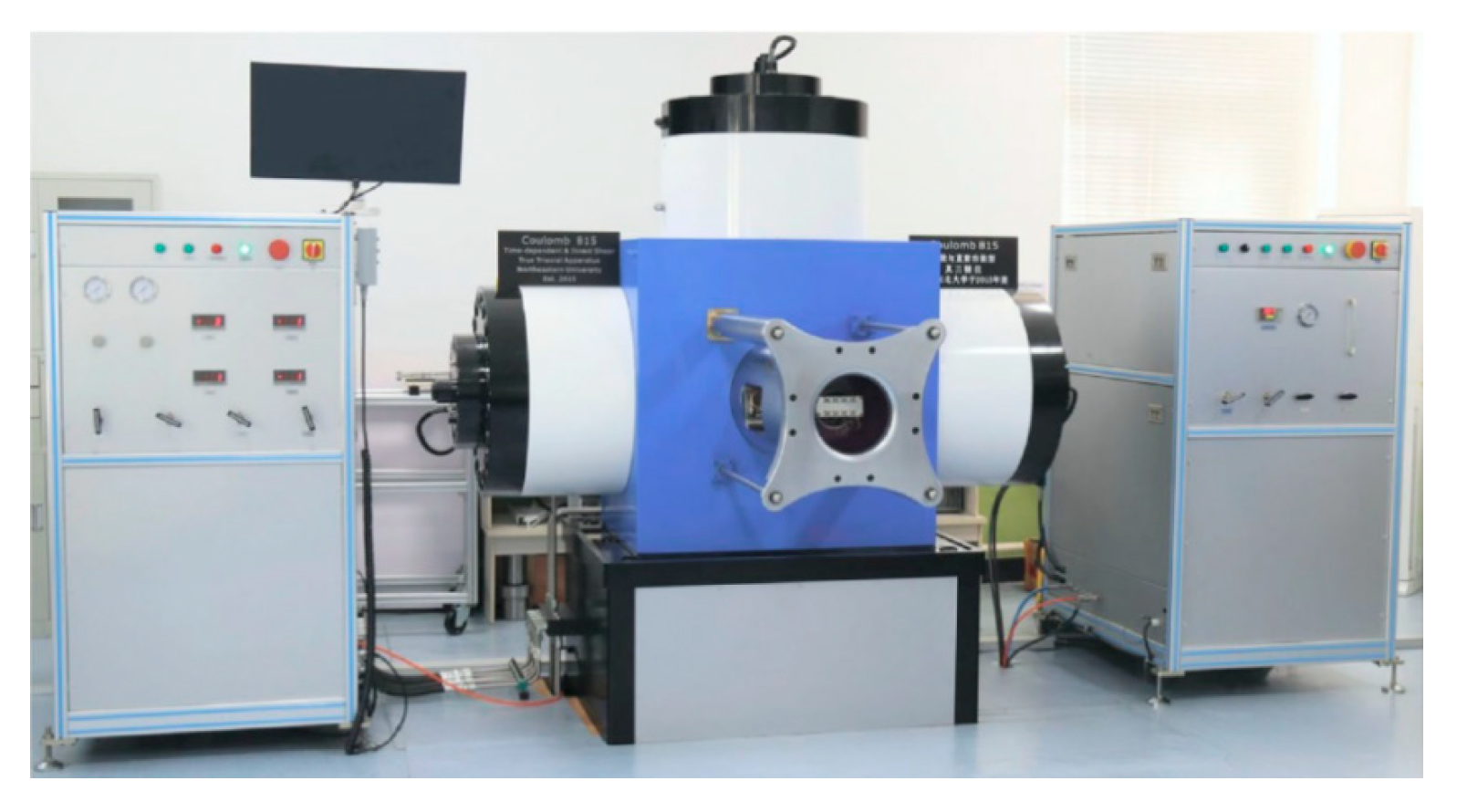

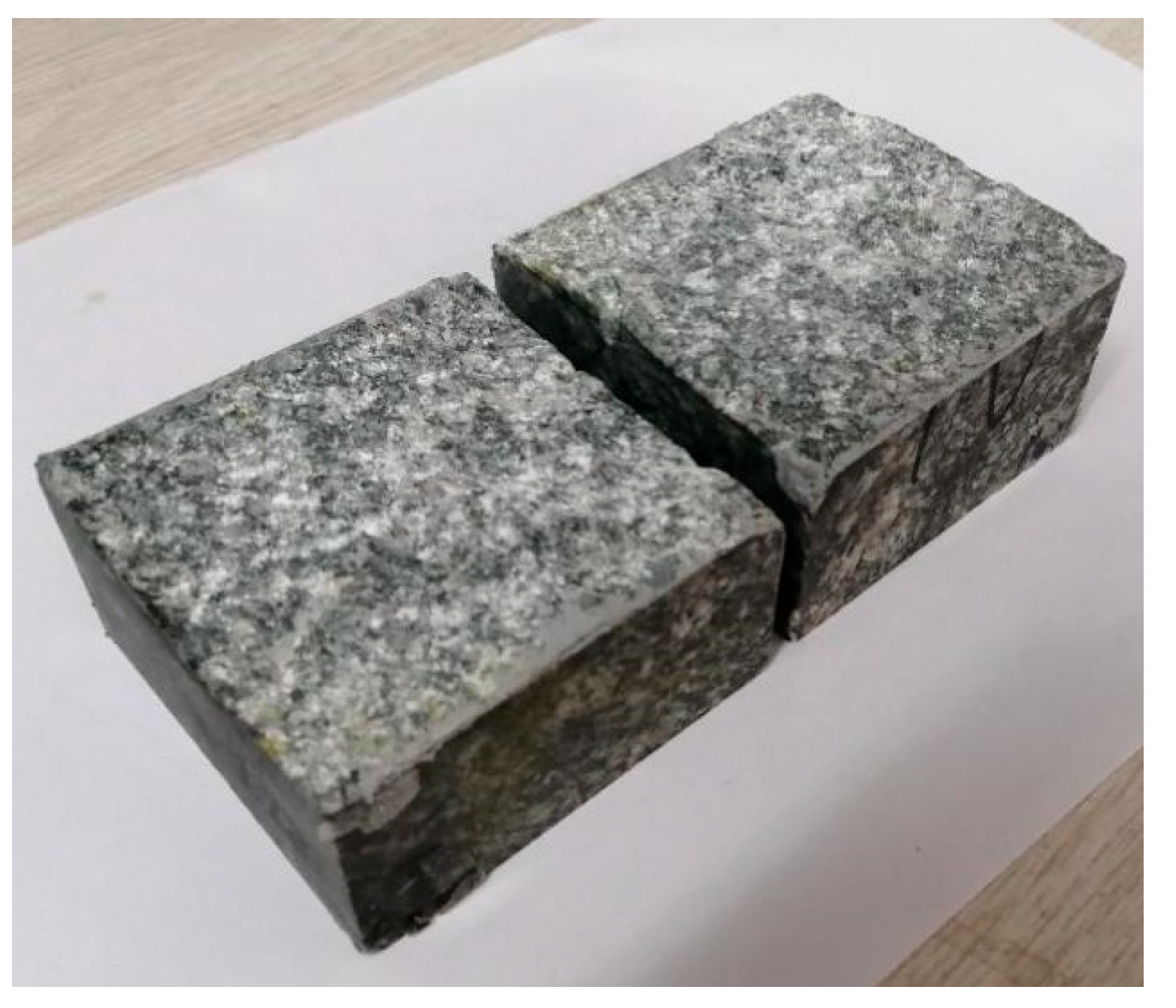
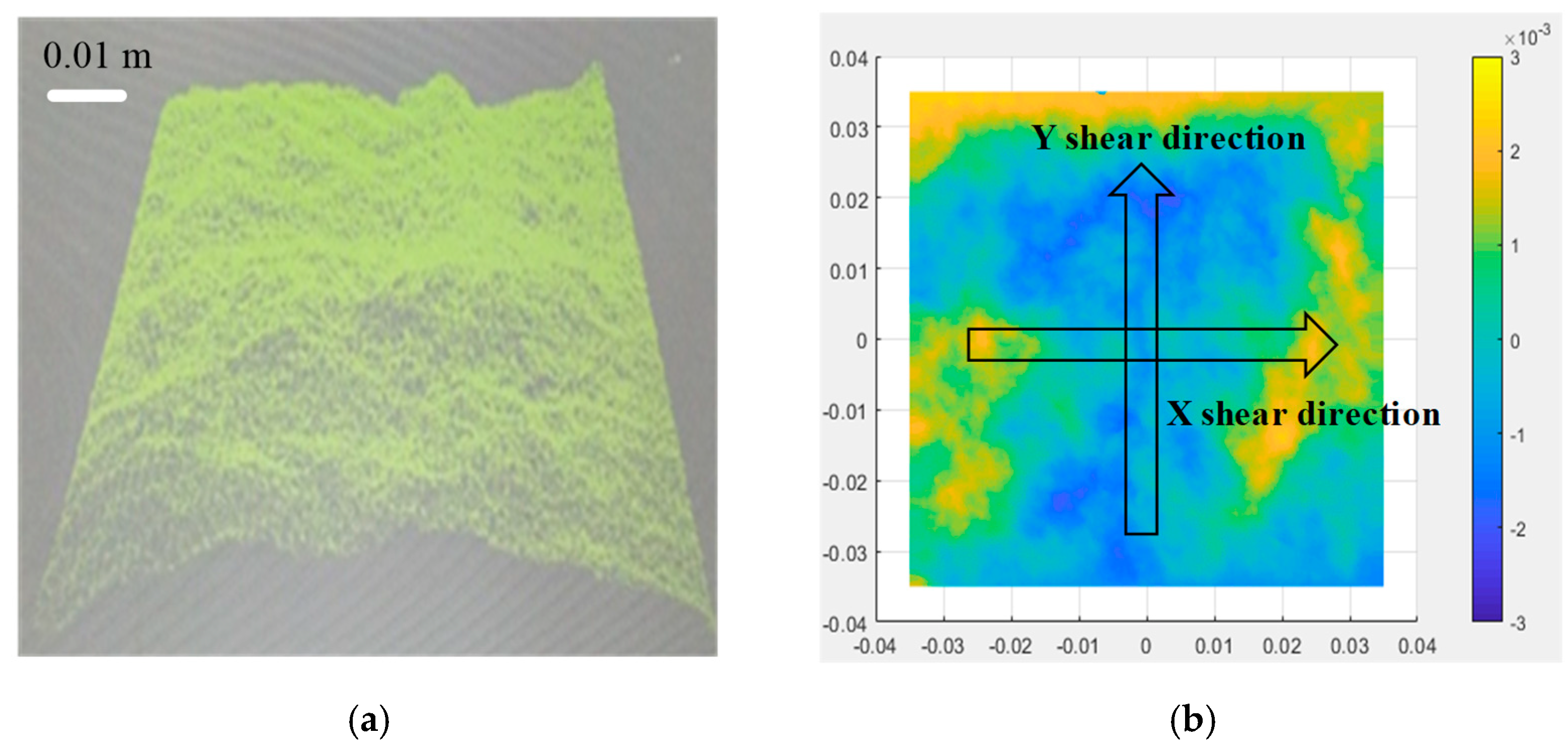
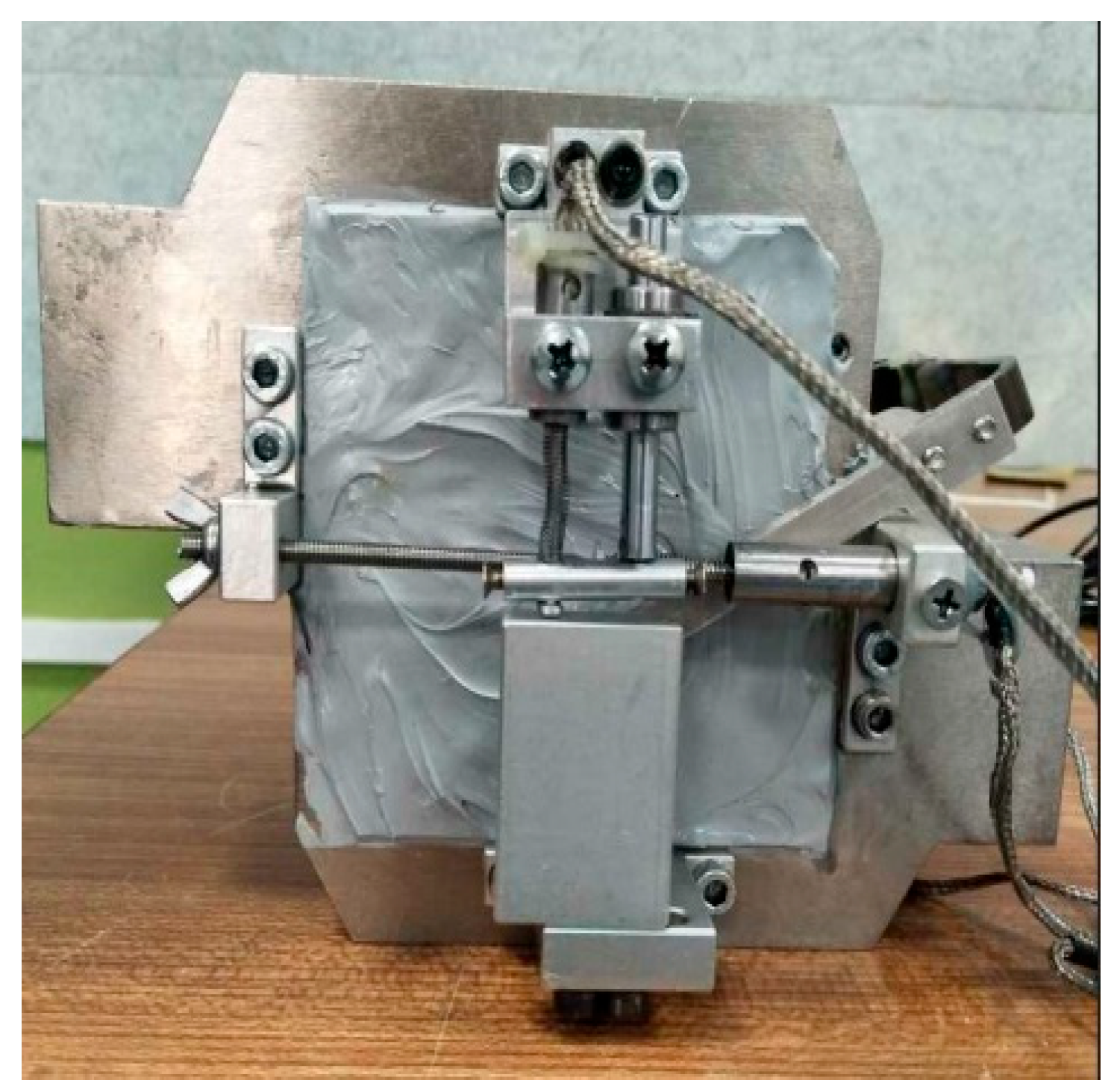
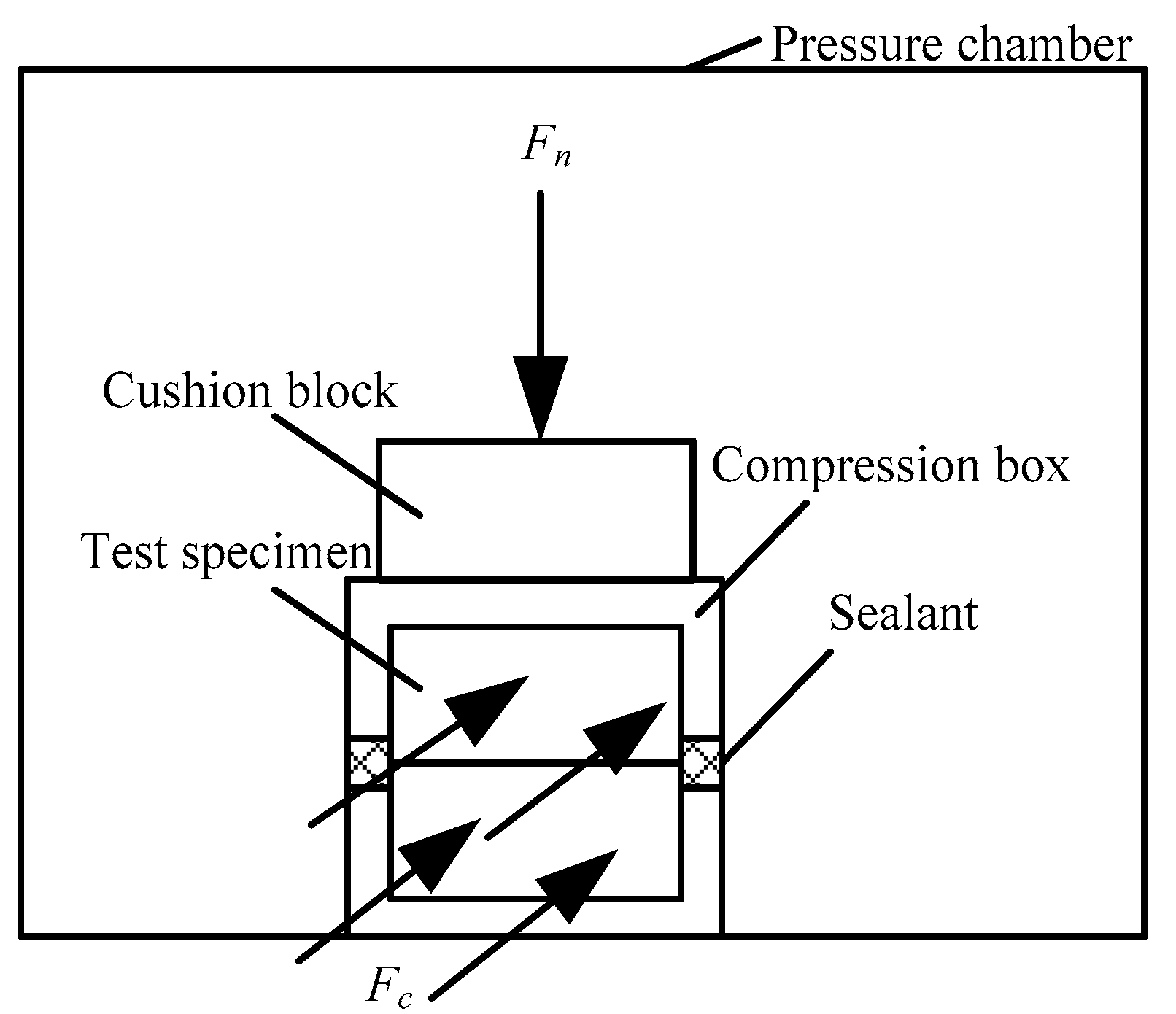
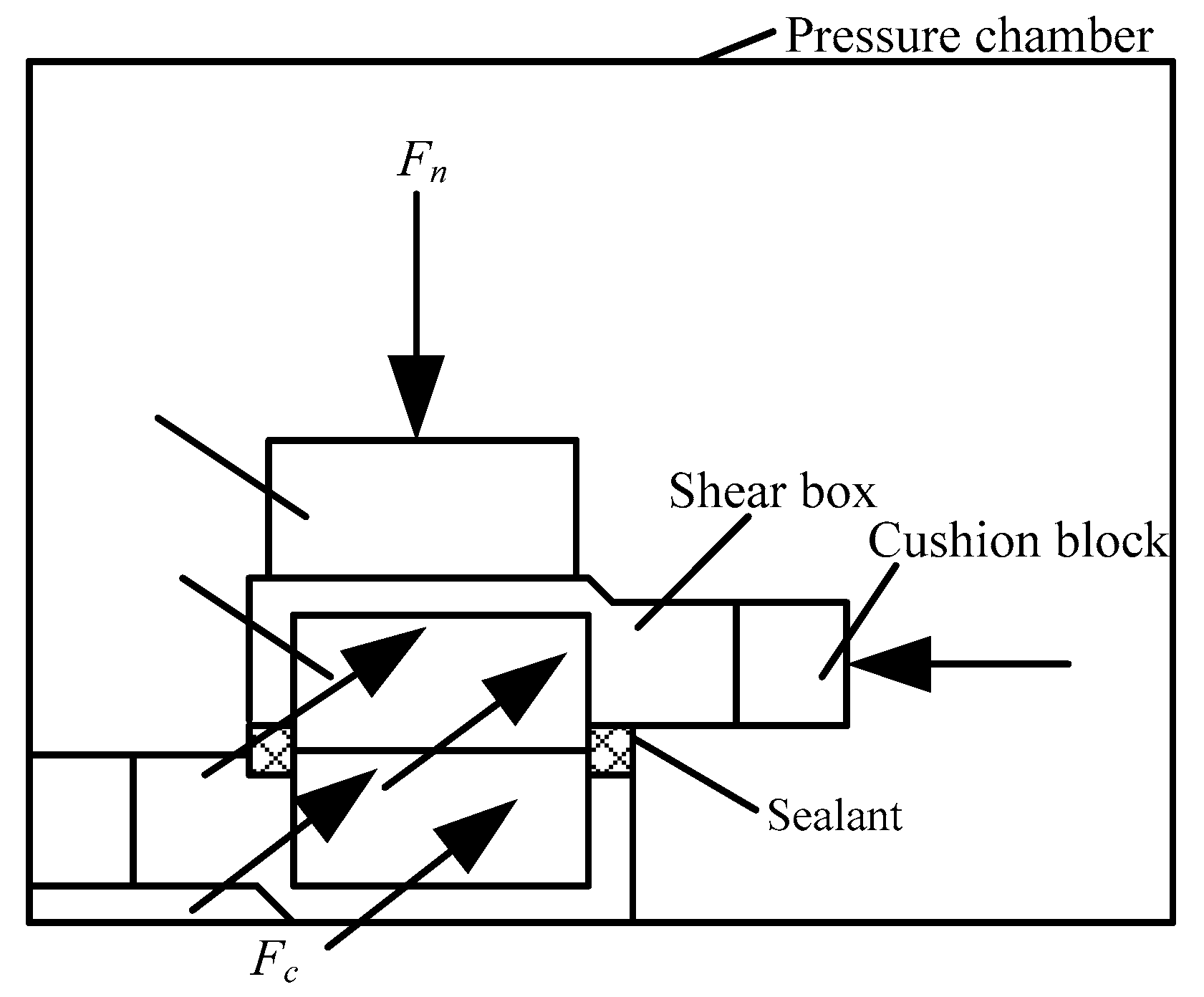

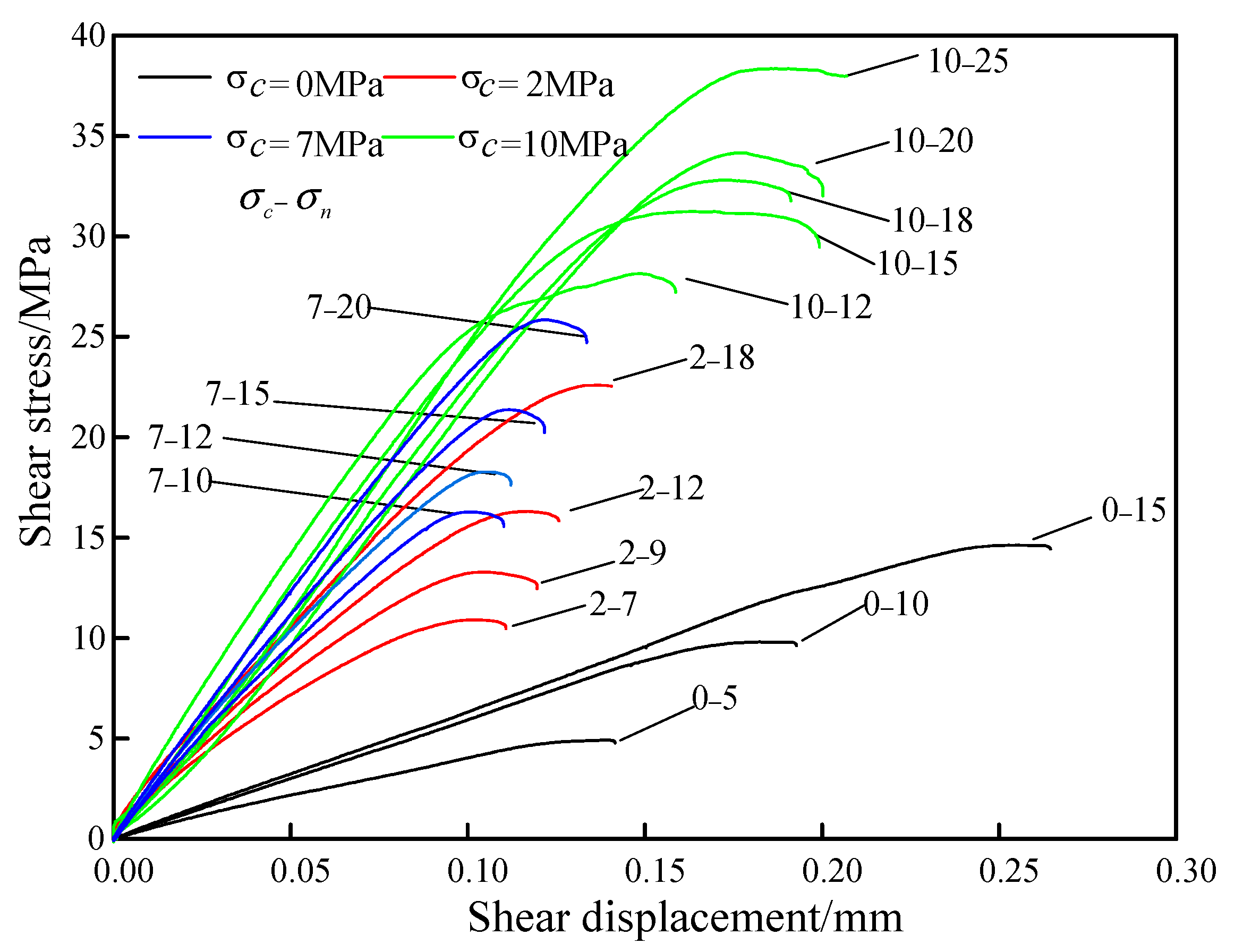
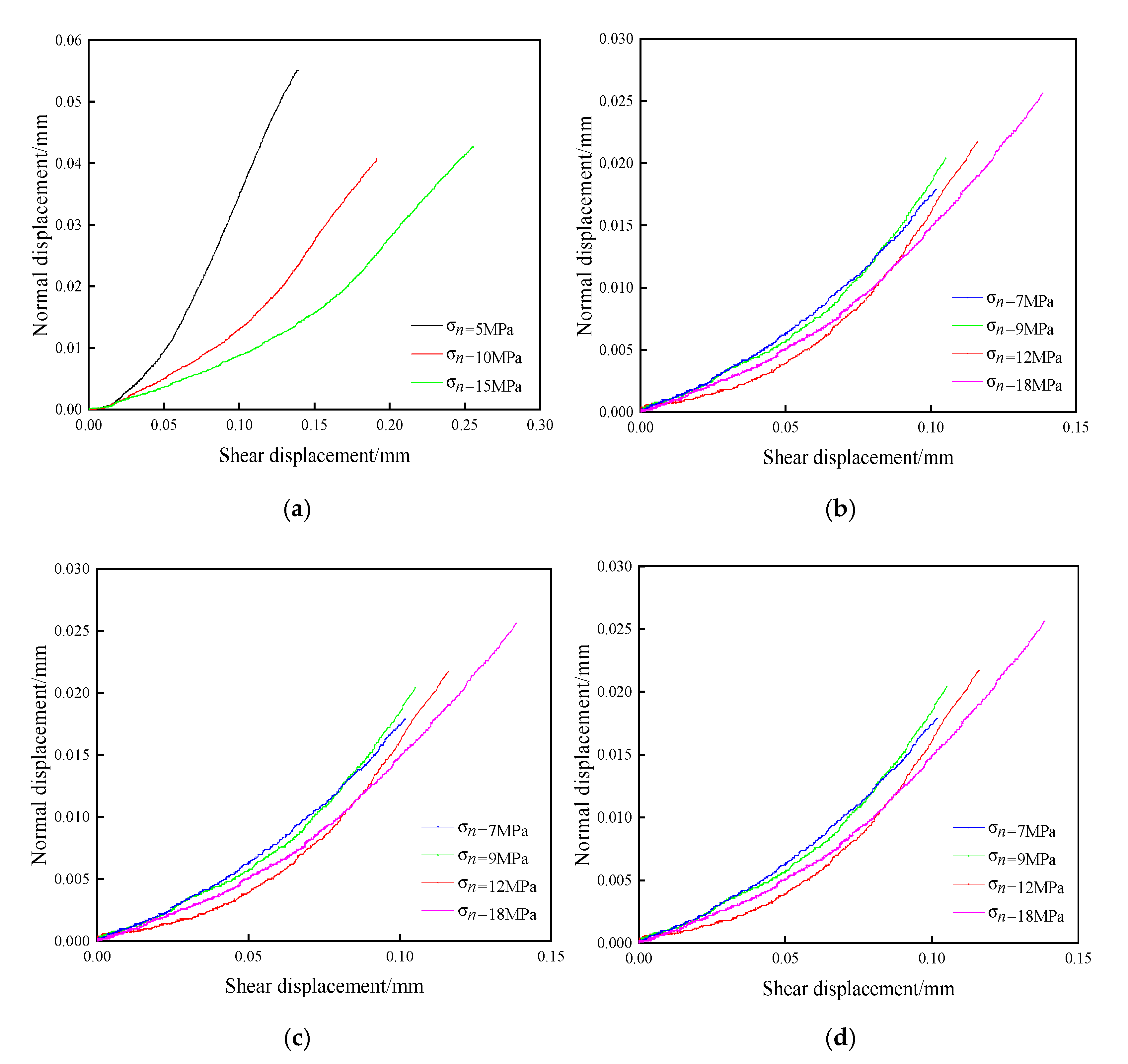
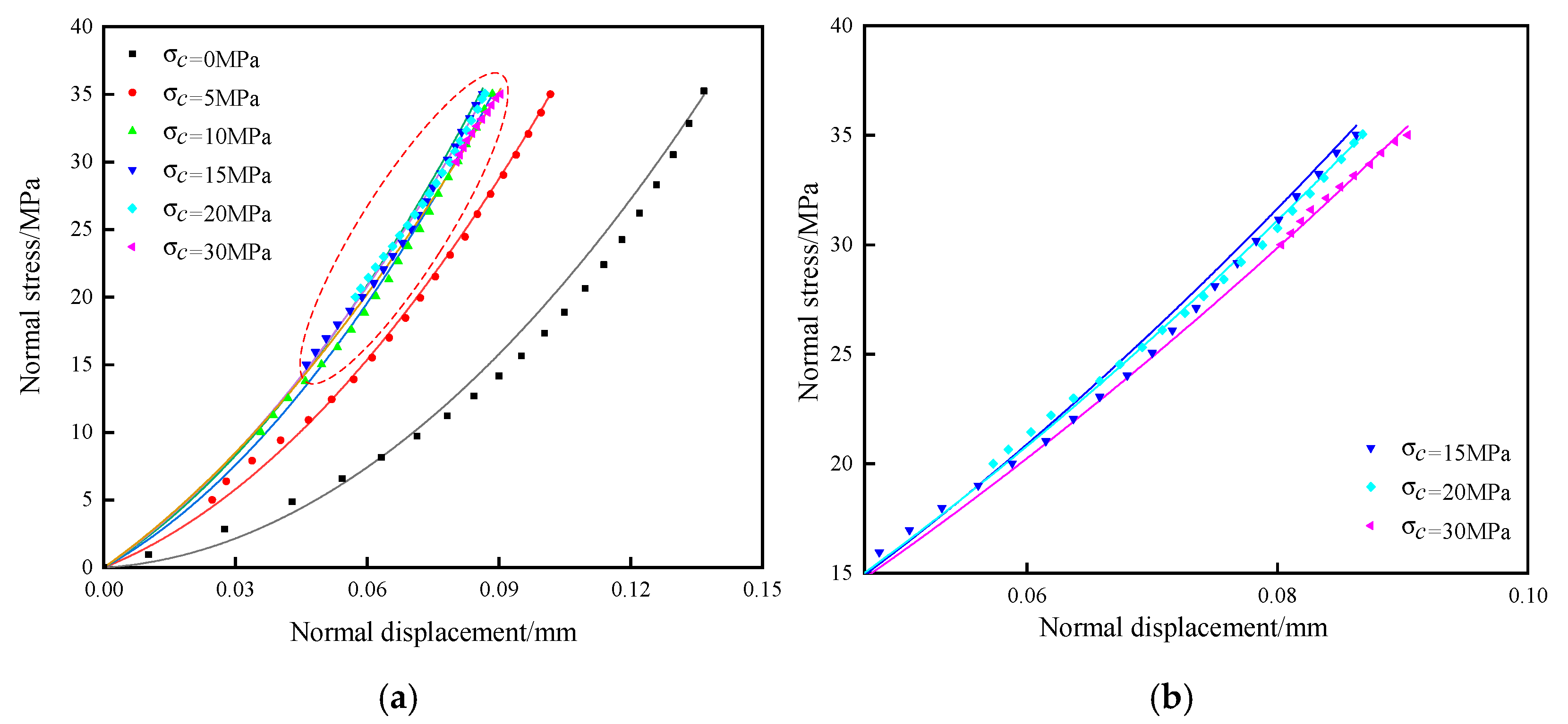
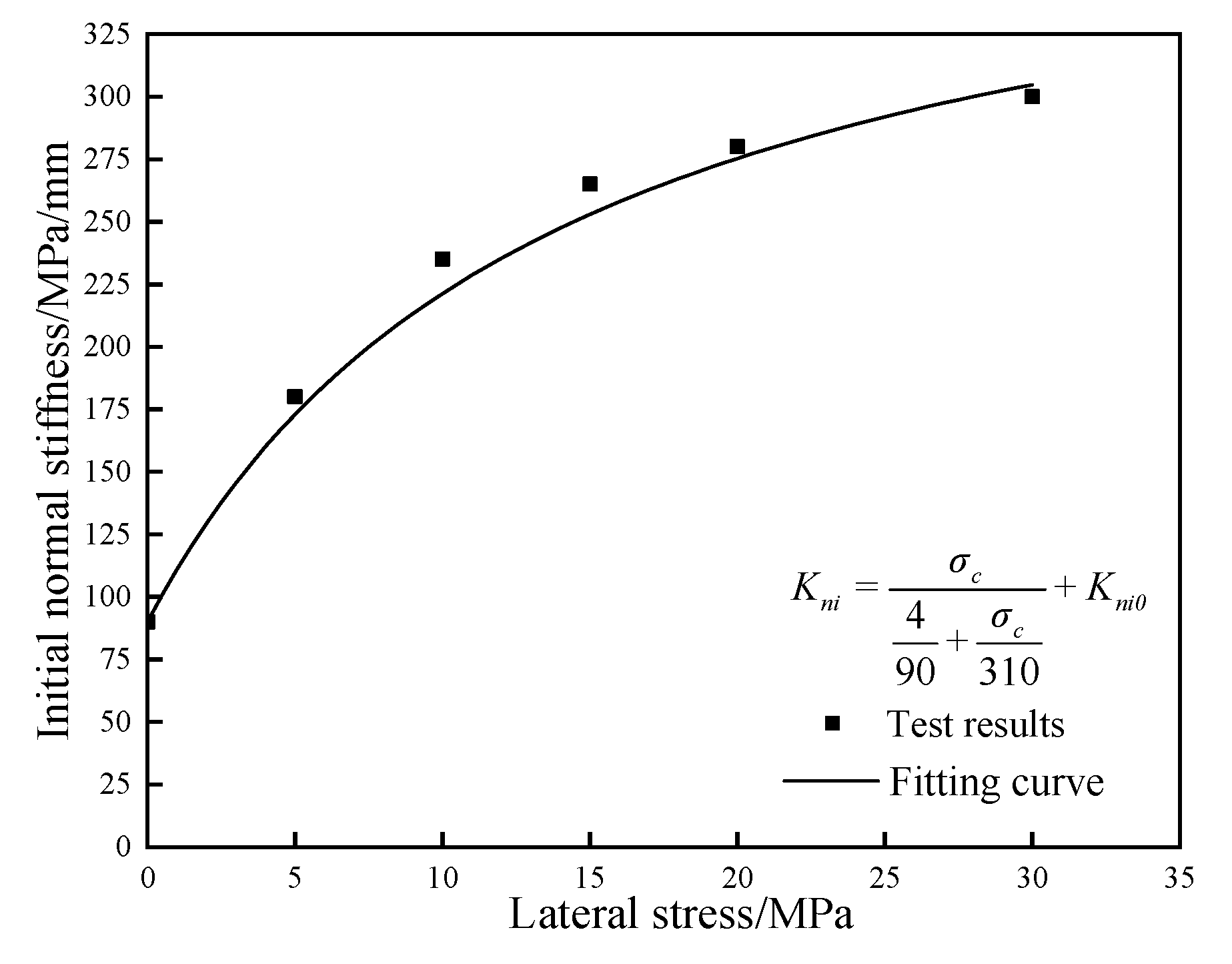
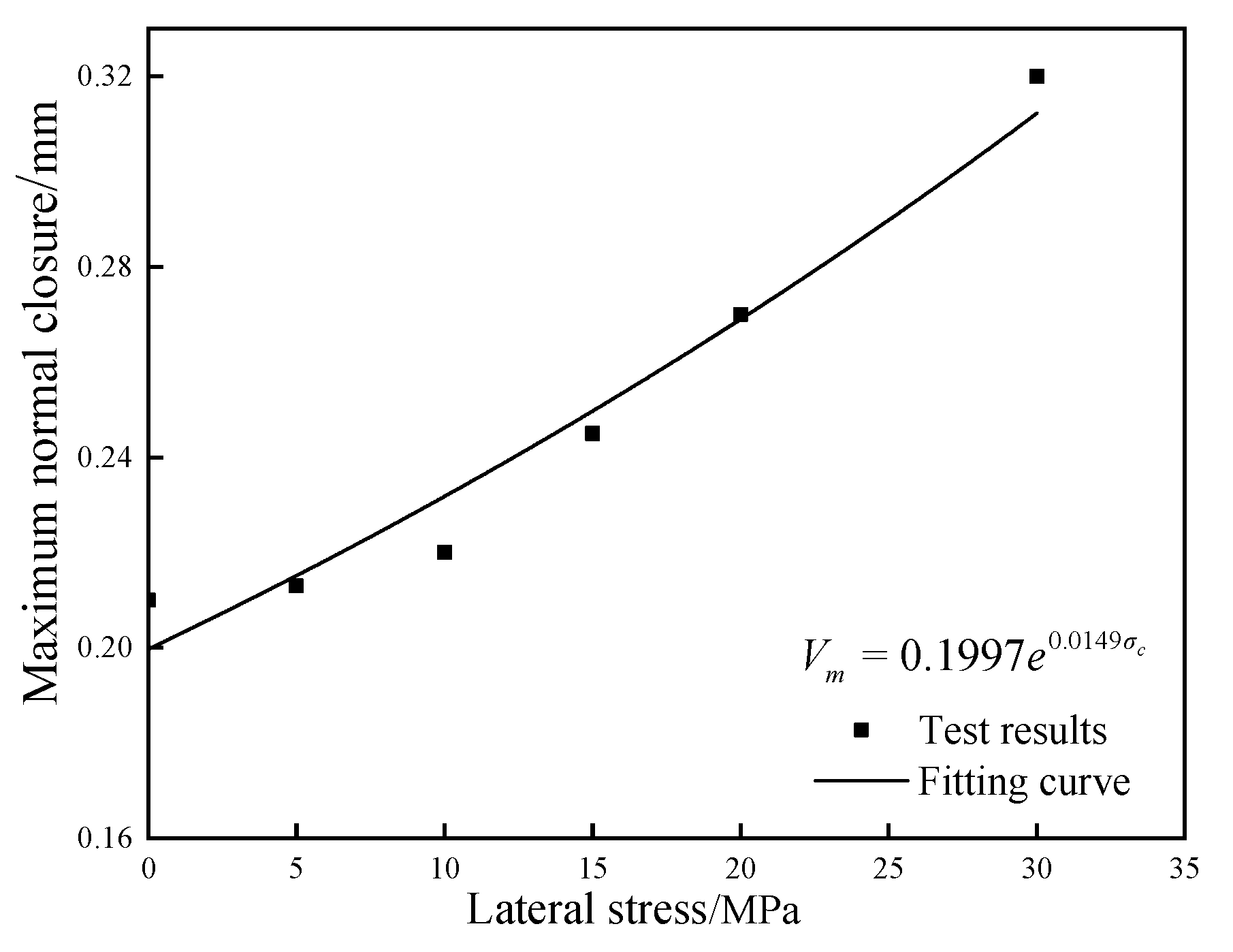
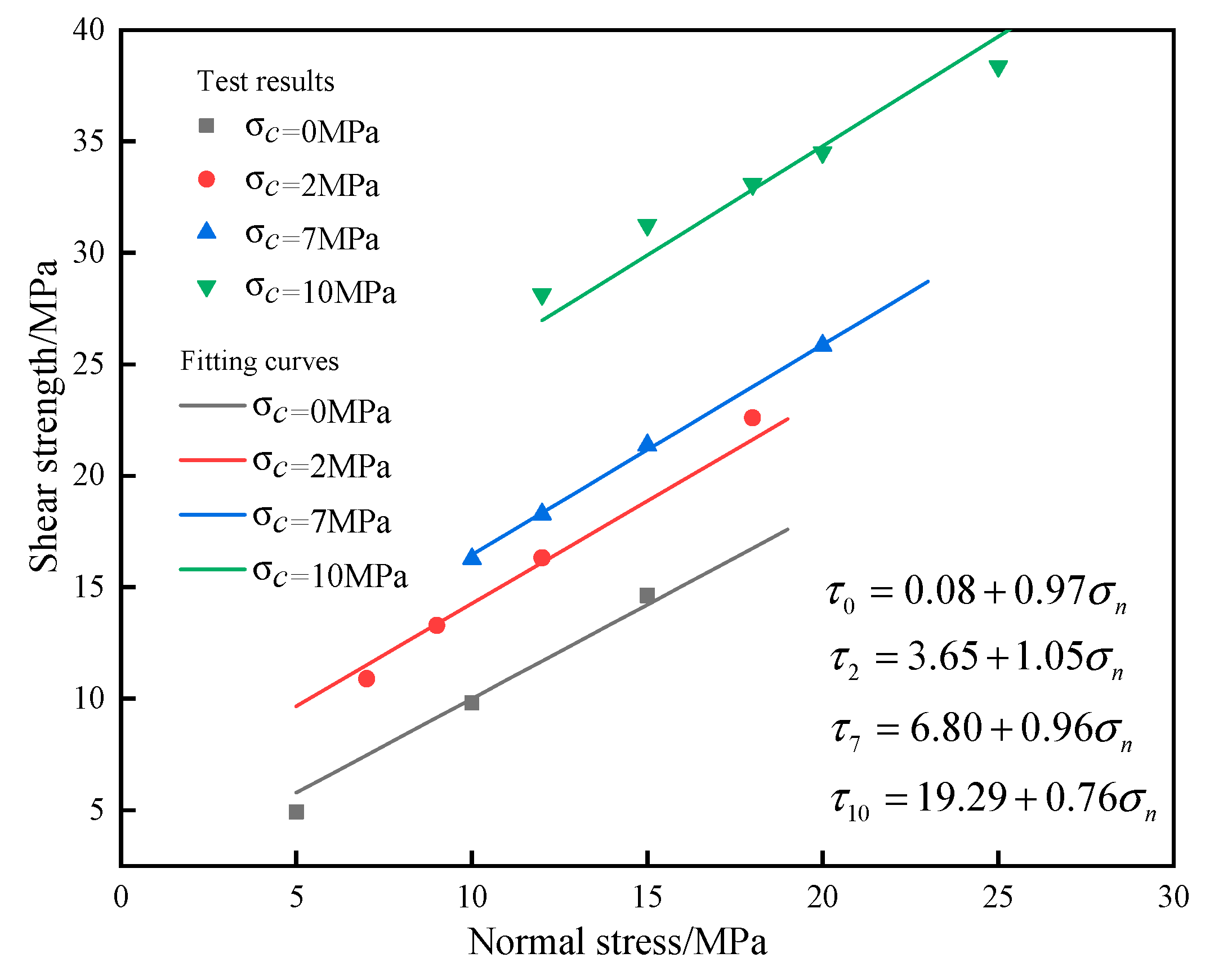
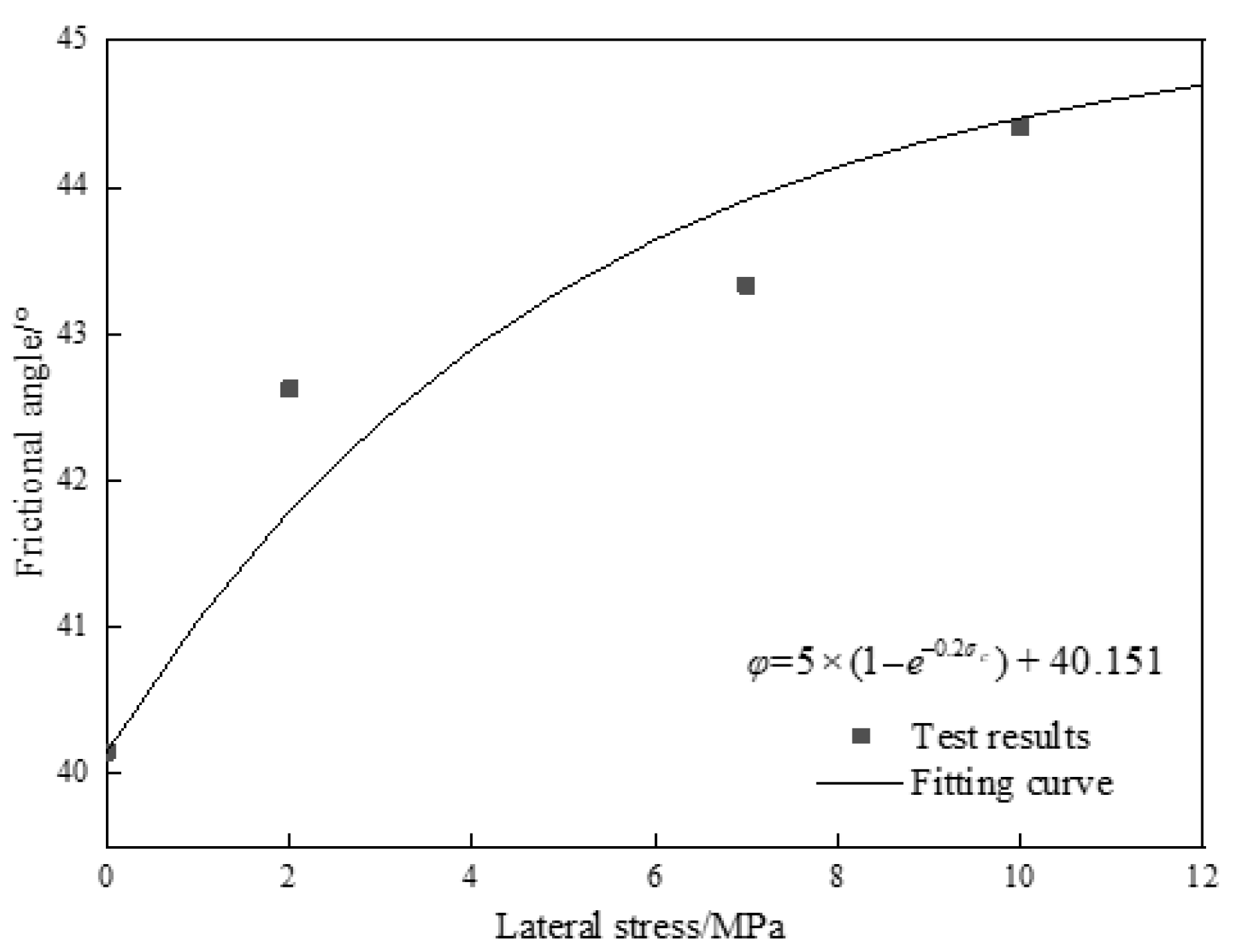
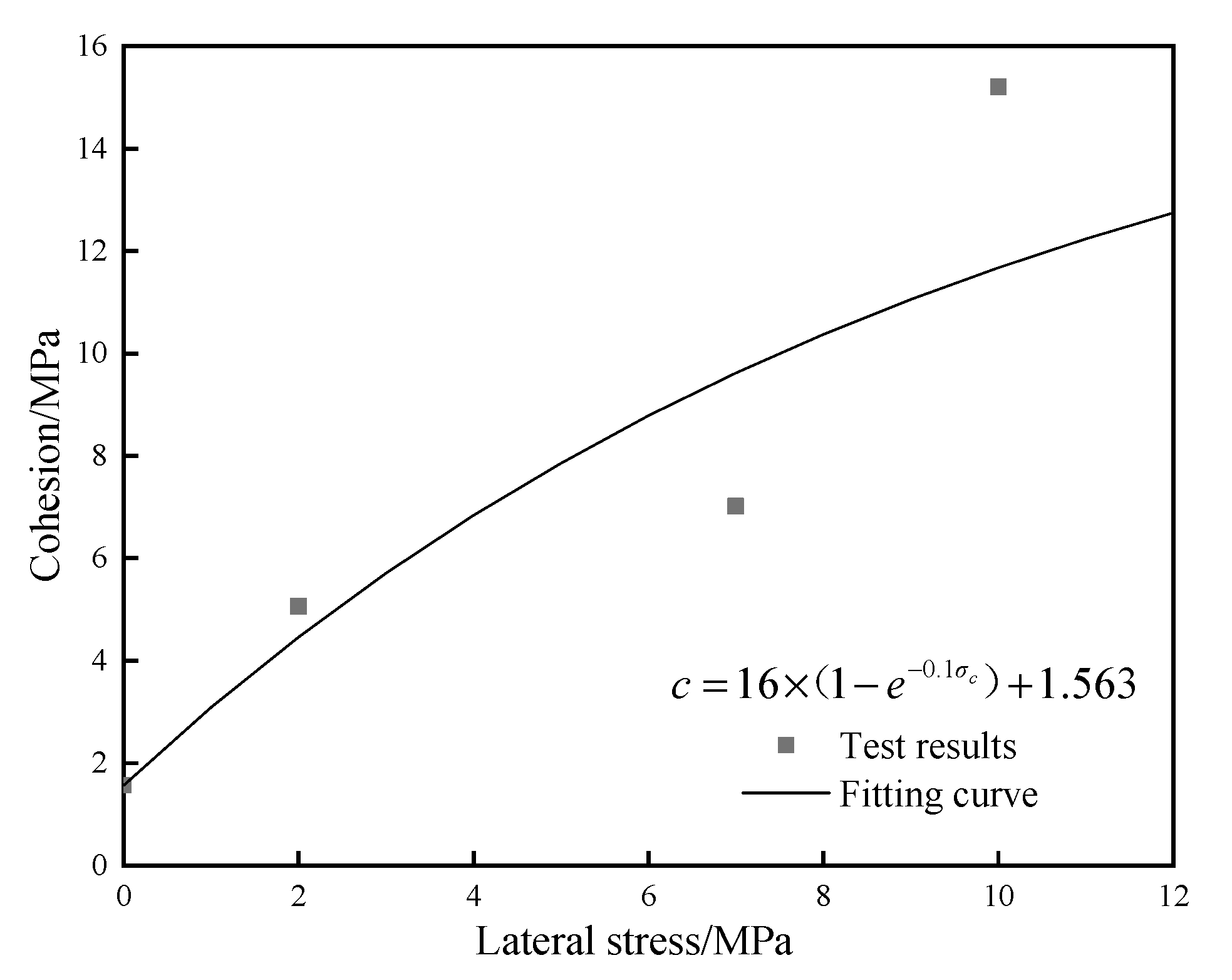
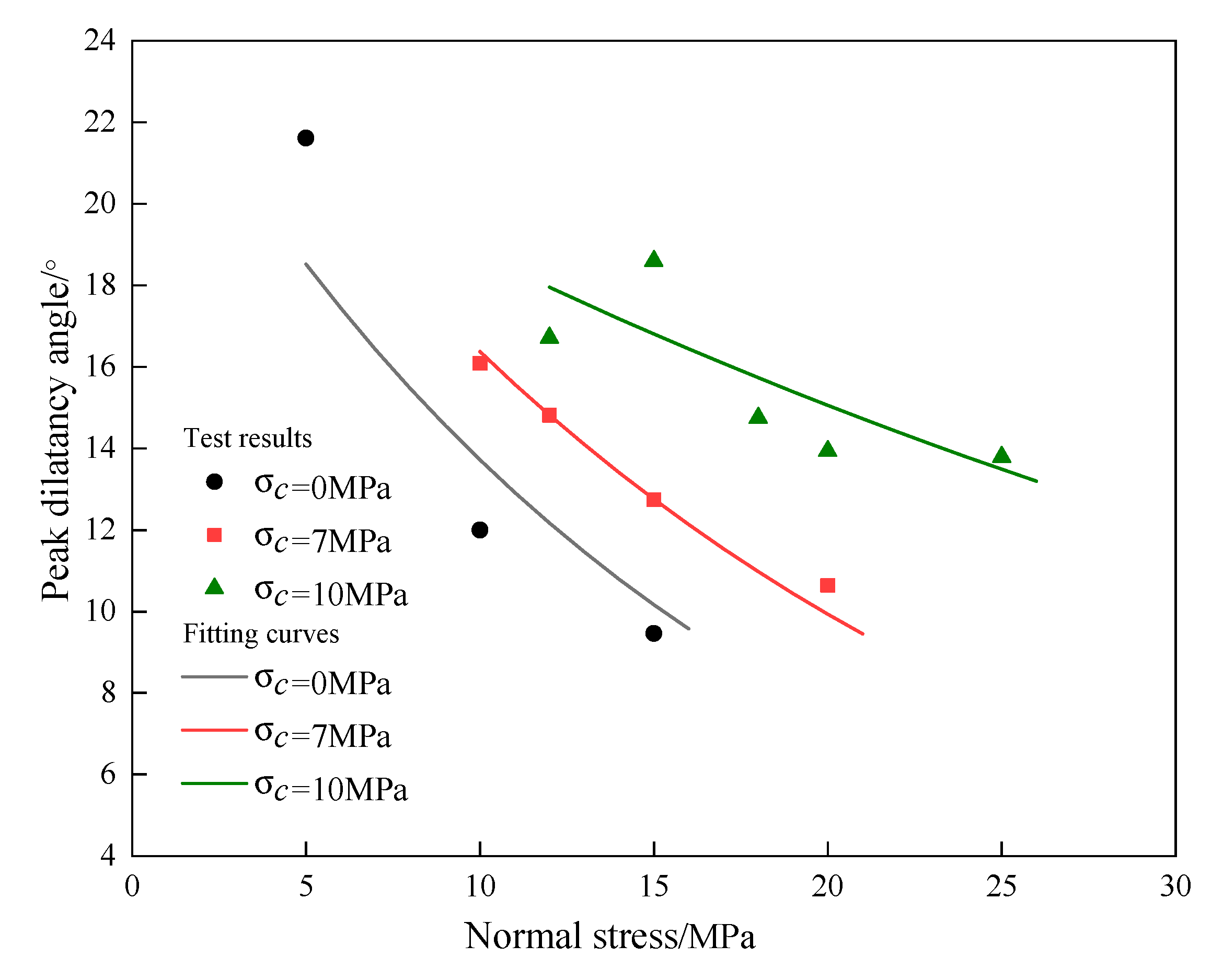
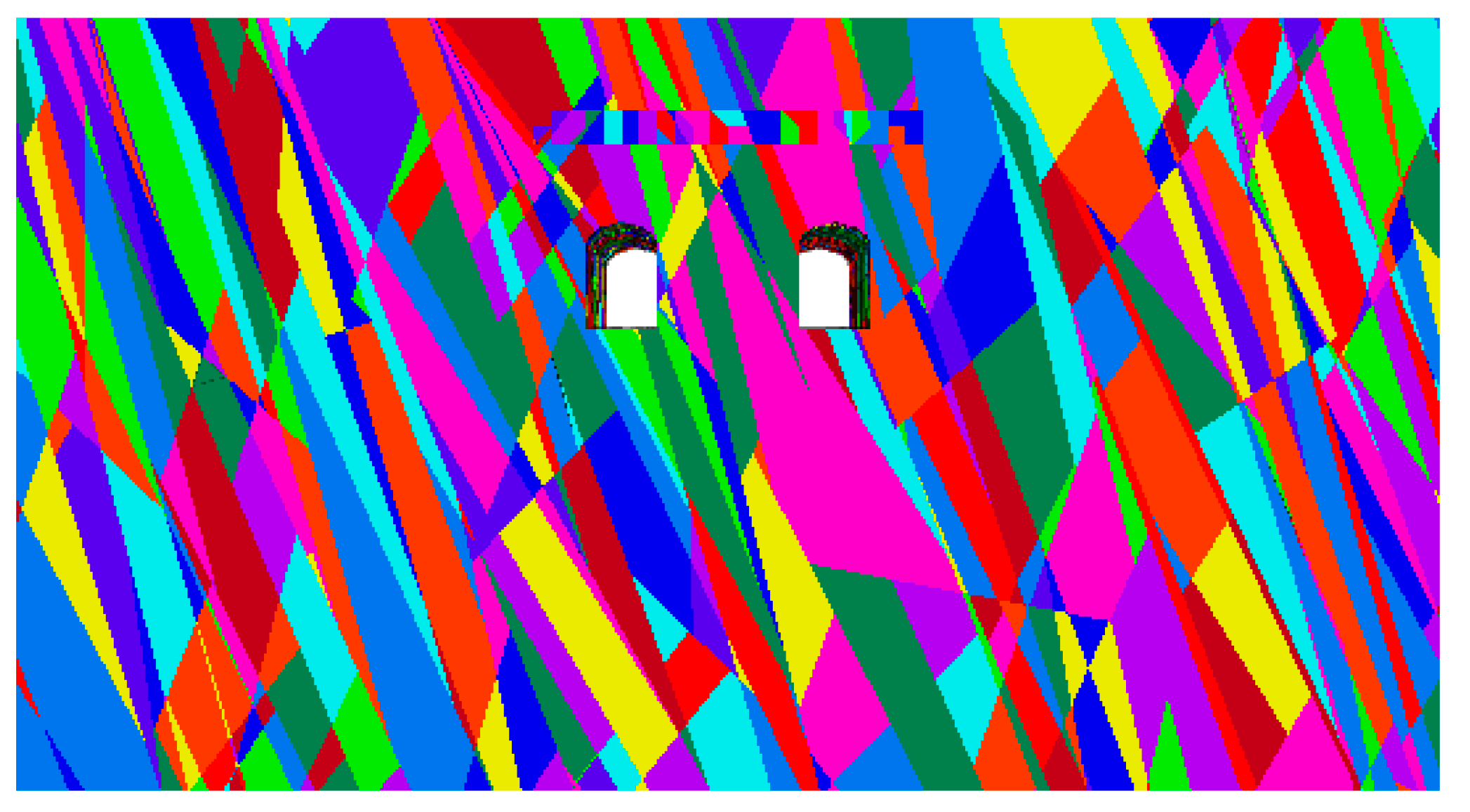


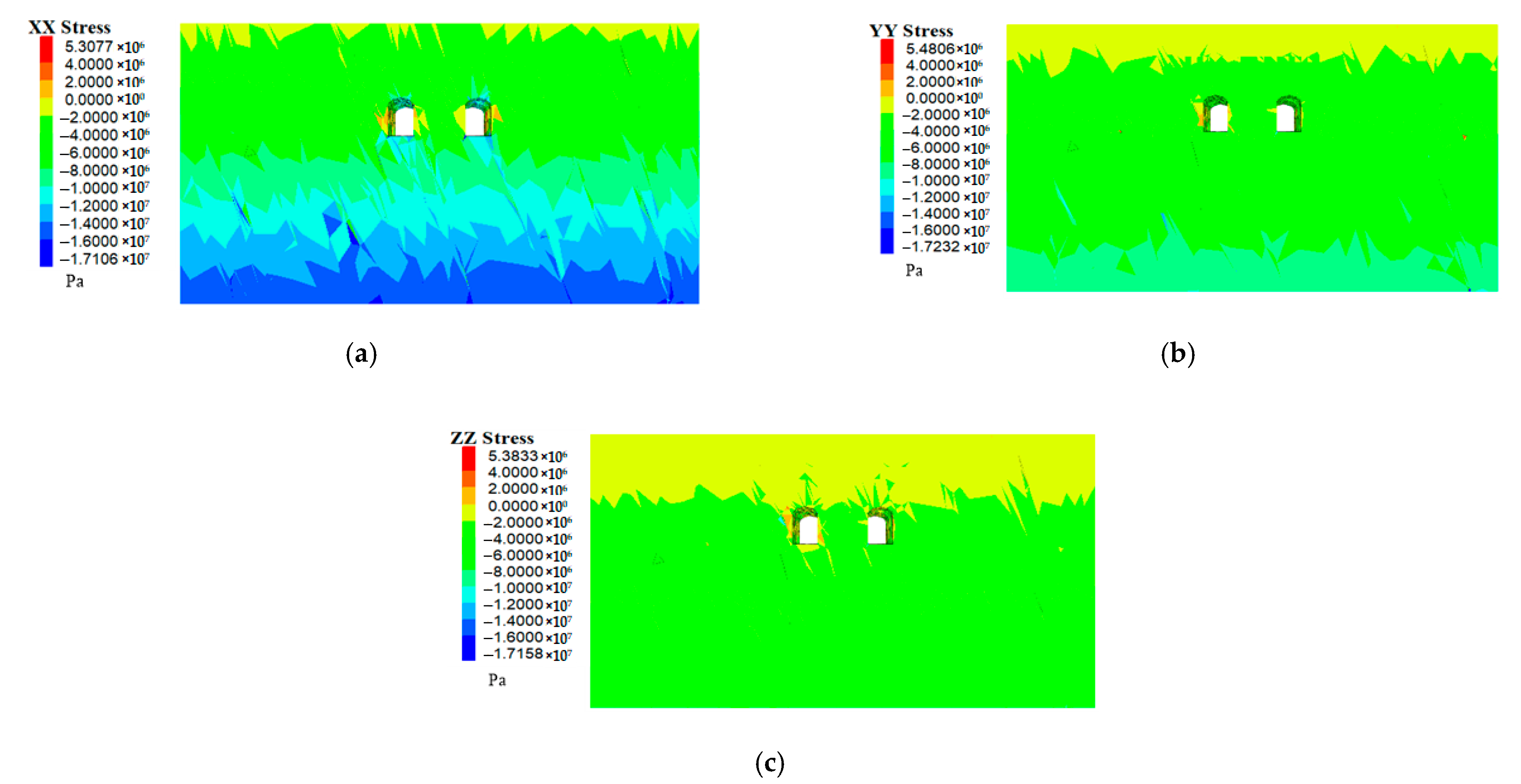
| Specimen No. | X Direction | Y Direction |
|---|---|---|
| #1 | 10.05 | 10.87 |
| #2 | 10.92 | 10.54 |
| #3 | 10.15 | 11.32 |
| #4 | 10.70 | 12.33 |
| #5 | 9.25 | 11.96 |
| Cases | Normal Stress | Lateral Stress |
|---|---|---|
| #5-1 | 35 + 0 | 0 |
| #5-2 | 30 + 5 | 5 |
| #5-3 | 25 + 10 | 10 |
| #5-4 | 20 + 15 | 15 |
| #5-5 | 15 + 20 | 20 |
| #5-6 | 5 + 30 | 30 |
| Cases | Normal Stress | Lateral Stress |
|---|---|---|
| #1 | 5–10–15 | 0 |
| #2 | 7–9–12–18 | 2 |
| #3 | 10–12–15–20 | 7 |
| #4 | 12–15–18–20–25 | 10 |
| Cases | Normal Stress | Shear Strength | Peak Shear Displacement (%) | Peak Dilatancy Angle (°) |
|---|---|---|---|---|
| #1 | 5 | 4.920 | 0.139 | 21.6 |
| 10 | 9.801 | 0.191 | 11.99 | |
| 15 | 14.609 | 0.262 | 9.46 | |
| #2 | 7 | 10.901 | 0.102 | 11.1 |
| 9 | 13.288 | 0.105 | 11.39 | |
| 12 | 16.313 | 0.116 | 10.59 | |
| 18 | 22.591 | 0.138 | 10.48 | |
| #3 | 10 | 16.280 | 0.101 | 16.09 |
| 12 | 18.280 | 0.105 | 14.80 | |
| 15 | 21.371 | 0.112 | 12.74 | |
| 20 | 25.851 | 0.121 | 10.64 | |
| #4 | 12 | 28.147 | 0.149 | 16.72 |
| 15 | 31.154 | 0.175 | 18.37 | |
| 18 | 32.800 | 0.172 | 14.75 | |
| 20 | 34.168 | 0.177 | 13.94 | |
| 25 | 38.354 | 0.186 | 13.79 |
| Cases | Initial Normal Stiffness | Maximum Normal Closure | |
|---|---|---|---|
| #5-1 | 90 | 0.21 | 0.9873 |
| #5-2 | 180 | 0.213 | 0.9980 |
| #5-3 | 235 | 0.22 | 0.9991 |
| #5-4 | 265 | 0.245 | 0.9920 |
| #5-5 | 280 | 0.27 | 0.9937 |
| #5-6 | 300 | 0.32 | 0.9807 |
| No. | Dip Angle | Trace Length L1 (m) | Trace Length Spacing S (m) |
|---|---|---|---|
| #1 | 80–95 | 29–47 | 5.0–7.0 |
| #2 | 79–85 | 30–40 | 5.1–7.4 |
| #3 | 86–91 | 39–52 | 5.1–6.0 |
| #4 | 76–81 | 43–52 | 5.0–10.0 |
| Density | Elastic Modulus Er (Gpa) | Poission’s Ratio |
|---|---|---|
| 2.68 | 21.6 | 0.27 |
| Lateral Stress | Shear Stiffness | Normal Stiffness | Friction Angle | Cohesion | Dilatancy Angle (°) |
|---|---|---|---|---|---|
| 0 | 47 | 90 | 40.2 | 1.6 | 11.4 |
| 3.5 | 169 | 152 | 42.6 | 6.3 | 12.6 |
| 7 | 209 | 194 | 43.9 | 9.6 | 15.2 |
| 10.5 | 233 | 224 | 44.2 | 11.9 | 17.4 |
| Lateral Stress (MPa) | Displacement of Left Cavern(mm) | Lateral Stress (MPa) | Displacement of Right Cavern (mm) | ||||
|---|---|---|---|---|---|---|---|
| Side Wall | Crown | Base | Side Wall | Crown | Base | ||
| 0 | 28.3 | 3.5 | 2.2 | 0 | 26.2 | 3.1 | 1.9 |
| 3.5 | 24.9 | 2.7 | 1.5 | 3.5 | 23.6 | 1.9 | 1.1 |
| 7 | 21.5 | 2.1 | 1.1 | 7 | 20.9 | 1.5 | 0.8 |
| 10.5 | 19.6 | 1.4 | 0.5 | 10.5 | 18.5 | 0.9 | 0.2 |
Publisher’s Note: MDPI stays neutral with regard to jurisdictional claims in published maps and institutional affiliations. |
© 2022 by the authors. Licensee MDPI, Basel, Switzerland. This article is an open access article distributed under the terms and conditions of the Creative Commons Attribution (CC BY) license (https://creativecommons.org/licenses/by/4.0/).
Share and Cite
Qiao, L.; Wang, Z.; Li, W.; Liu, H.; Yang, L. Effect of Lateral Stress on the Mechanical Properties of Rock Fracture and Its Implication on the Stability of Underground Oil Storage Caverns. J. Mar. Sci. Eng. 2022, 10, 677. https://doi.org/10.3390/jmse10050677
Qiao L, Wang Z, Li W, Liu H, Yang L. Effect of Lateral Stress on the Mechanical Properties of Rock Fracture and Its Implication on the Stability of Underground Oil Storage Caverns. Journal of Marine Science and Engineering. 2022; 10(5):677. https://doi.org/10.3390/jmse10050677
Chicago/Turabian StyleQiao, Liping, Zhechao Wang, Wei Li, Huan Liu, and Lei Yang. 2022. "Effect of Lateral Stress on the Mechanical Properties of Rock Fracture and Its Implication on the Stability of Underground Oil Storage Caverns" Journal of Marine Science and Engineering 10, no. 5: 677. https://doi.org/10.3390/jmse10050677
APA StyleQiao, L., Wang, Z., Li, W., Liu, H., & Yang, L. (2022). Effect of Lateral Stress on the Mechanical Properties of Rock Fracture and Its Implication on the Stability of Underground Oil Storage Caverns. Journal of Marine Science and Engineering, 10(5), 677. https://doi.org/10.3390/jmse10050677





